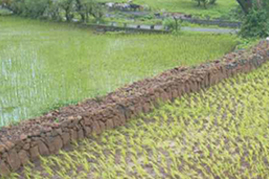
LEVELLING OF SLOPING FARMLANDS
“Leveling the ground in this uneven terrain is a project undertaken by the Trust. This allows the silt and water deposited in the fields during monsoon to be distributed evenly, helping to increase the productivity of the land. The soil retains moisture longer, helping the people to grow many winter crops such as tuwar chana, choli, red lentils, vaal, vatan and other lentils including chick peas and black-eyed peas.
Farmers wishing to level their fields first create a manuring pit intheir back yard. This is used to prepare fertilizer out of cow dung.At the time of leveling, the soil is churned so that fertile top soil is replaced with soil from underneath the land. To preserve the fertility of the soil, farmers are required to add cow dung fertilizer from the fertilizer pit, as a part of the process of land leveling.”
During last 7 years, over 3,868 farms inten villages are levelled. Trust is giving 4.5 Kg. of rice per cubic. Meter of work as an incentive to farmers took up levelling of their farms. Total 357,846 Kgs of Rice was diistributed as a work incentive to the farmers. Total @ Rs. 5.63 Millions are spent by the trust for levelling project.
PREVENTING SOIL EROSION WITH REESTRAINING WALL
As mentioned earlier the farm lands in the hilly regions of Dharampur Taluka are undulating. Due to the sloping gradients of this region most of the fertile top soil gets wa shed away during monsoons. In order to prevent this ; restraining walls are created in the fields, diagonal to the slope.
These restraining wall stop the fertile top soil from being washed away. This fertile soil collects near the embankment. Over 2 to 3 years, this soil helps the land around the embankments level out, and thanks to its quality, instead of growing inferior grains like Nagli, this area can now be usedfor a rich paddy harvest.
The hilly areas here are strewn with scattered and exposed rocks and stones. These are used while building embankments, thus clearing up the fields and leaving them fit to plough.
The embankments prevent the top soil from washing away, and it collects in a thick layer at the edges.This improves the ability of the landto retain water and moisture, which helps crops, trees and the surroundingjungle to get water for a longer duration.
The embankments also help to slow down the pace of rainwater runoff, which otherwise would happen very quickly on sloping land.This allows water to remain on the land for longer, and to penetrate deeper into the soil.
THUS, OVER THE lAST 16 YEARS
10,488 farmers in 30 villages have created 11,805 embankments
14,638 acres of land have been protected from erosion
328,010 cubic meters of embankments work has been done.
10,60,509 kilos of grain was given as an incentive to the farmers.
Rs. 15.17 Million was spent on this activity.
The avrage grain production increased @ 500 Kgs. Per Acre after embankment work in 14,638 acres of land, I.e. Increased in grain production of 73,19,000 Kgs.
On an average of 15 Rs./kilo as the rate of paddy, the increase in production worked out to about Rs.109.78 Million.
Means, whatever the amount trust had spend, the impact on the community has been sevenfold, resulting in a considerable increase in the standard of living.
© 2024 Sarvodaya Parivar Trust. All rights reserved.
